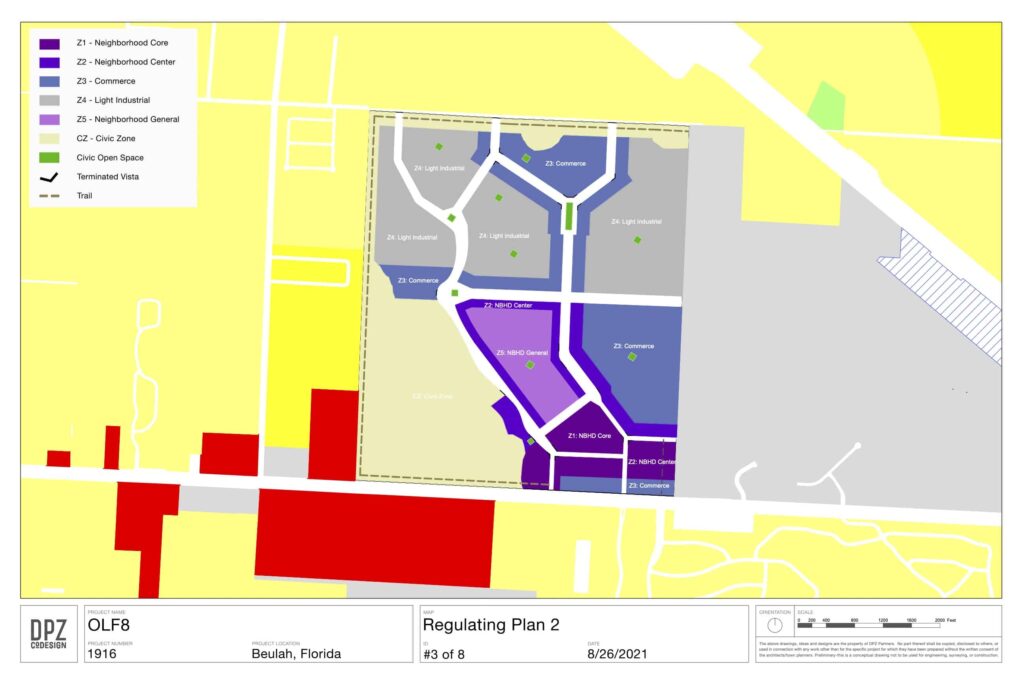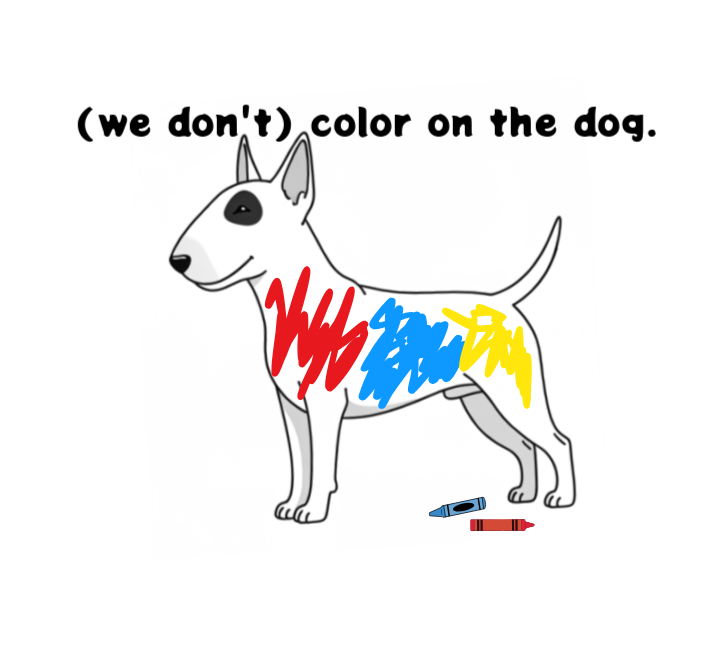
Beulah advocate Theresa Blackwell professes to love the OLF-8 Master Plan created by the DPZ Co-Design and approved by the Board of County Commissioners. The DPZ CoDesign plan consists of a 540-acre mixed-use project, including 271 acres for a light industrial district, 61 acres for residential and 47 acres for a mixed-use center.
- At her neighborhood meeting on Tuesday, Blackwell said, “We’re ridiculously fortunate that little Beulah got DPZ.”
However, in her recent PNJ column, she didn’t want to follow the master plan regarding job creation and the industries allowed in the Light Industrial District.
- She wrote, “We do not need to fill up the light industrial land with advanced manufacturing, as the UWF Haas Center presented at one of the meetings. That would likely be out-of-town companies, with many out-of-county workers. We need a diversity of job opportunities in our large town of Beulah.”
WHAT SHE IS NOT TELLING YOU: In 2021, DPZ Co-Design hired the University of West Florida Haas Center to the OLF-8 Impact Study for the master plan. The Light Industrial and Commerce area (271 acres) was to focus on creating high-tech, high-wage jobs in alignment with regional and state-targeted industries.
DPZ engaged the Haas Center to assess several economic impact scenarios for Outlying Field 8 (OLF8).
From the report: “First, the client (DPZ) sought to understand the potential economic impact of commercial expansion for various targeted industries in Escambia County. Center staff selected industries based on two criteria: existing jobs and alignment with regional and state-targeted industries (see page 3). To project the impacts of the commercial expansion within these industries, staff examined 4 employment intervals: 1,000, 2,000, 3,000 and 4,000 jobs. The results included the total sum of direct, indirect and induced jobs, the total labor income, and the total output.”
2) “Furthermore, the client (DPZ) requested a comparison of two construction plans that differed in terms of investment as well as the pace at which the investment was expended in the county. The client provided estimated costs for construction. They valued the total investment for the construction of Plan A at $669,341,800. Construction spending was anticipated to occur at different increments across a 20-year timeframe…By comparison, the total construction costs for Plan B were estimated to be $969,783,400. Like Plan A, the spending in Plan B was anticipated to occur at 4 intervals across a 20-year timeframe…”
3) “Lastly, the client (DPZ) required guidance on the projected economic and fiscal impact of retail sales for OLF8 as it begins to take shape as a campus for high-tech, high-wage jobs. Staff modeled this over a period of 10 years, beginning in 2023. The assumptions are found on page 7. Haas Center staff ran an impact scenario for each of the considered plans through an econometric simulation that forecasts the outcome of new construction spending and jobs in targeted industries.”
What are the targeted industries that were identified:
- Custom computer programming services
- Turbine generator parts manufacturing
- Scientific research and development services
- Medical and diagnostic lab
- Computer systems design services
- Metal window and door manufacturing
- Propulsion units & parts for space vehicles & guided missiles manufacturing
- Warehousing and storage
- Management consulting services
Not all these industries are “advanced manufacturing,” but several are. Please read the report. The ordinance 2021-39 clearly lays out the Light Industrial Areas – Please read the ordinance here. Here is the approved OLF-8 Master Plan layout – Light Industrial in gray areas:
DPZ DESIGN CODE
The DPZ Design Code – which is also part of the ordinance – sets up Z4: “Light Industrial District: A medium intensity district, consisting of light industrial and commercial/office uses. Residential uses are prohibited in this district. Buildings should be set close to the sidewalk and parking, and servicing should be screened from public frontages.”
What is permitted in Z4 District:
Permitted Industrial Uses: Light Industrial, Microbreweries, Microdistileries, Microwineris, Printing, Lithography and Wholesale Warehousing.
- These uses fit the county’s Land Development Code, which states Light industrial uses include “research and development, printing and binding, distribution and wholesale warehousing, and manufacturing, all completely within the confines of buildings and without adverse off-site impacts.”
Not Permitted: Bulk Storage, Heavy Industrial, Borrow Pits, Solid Waste Collection or Processing
Permitted Public/Civic: Emergency Services Facilities, Hospitals, Places of Worship, Public Utility Structure, Warehouse/Maintenance Facility.
Permitted Retail Sales & Services: Car Wash, Repair Services
Permitted Entertainment: Commercial Entertainment
Permitted Agriculture: Farm Equipment & Supply Stores, Nurseries & Garden Centers, Produce Display, Veterinary Clinics.
Permitted Other: Building or Construction Trade Shops, Industrial Park, Outdoor Display of Plants, Outdoor Sales, Self Storage, Parking Garage
ADVANCED MANUFACTURING
Blackwell’s dreaded “advanced manufacturing” would not be permitted if its heavy industrial, but she uses the words without defining them.
I asked AI to define Advanced Manufacturing – it appears to fit under the permitted Light Industrial uses:
Advanced manufacturing refers to the use of innovative technologies and methods to improve efficiency, productivity, and competitiveness in the manufacturing sector[1][2]. It encompasses a wide range of cutting-edge techniques and processes that enhance the entire value chain, from product conception to end-of-life considerations[2].
## Key Aspects of Advanced Manufacturing
**Innovative Technologies**: Advanced manufacturing integrates various technologies, including:
– Automation and robotics
– Artificial Intelligence (AI) and Machine Learning
– Internet of Things (IoT)
– Additive manufacturing (3D printing)
– Advanced materials and composites
– Big data processing and analytics[2][3]
**Improved Processes**: These technologies enable manufacturers to:
– Optimize production strategies
– Enhance product quality
– Reduce time-to-market
– Minimize material waste
– Increase flexibility and customization capabilities[3][4]
**Research and Development**: Advanced manufacturing heavily relies on ongoing R&D efforts to push technological boundaries and create state-of-the-art products[4].
## Comparison with Traditional Manufacturing
Advanced manufacturing differs from traditional manufacturing in several ways:
| Aspect | Traditional Manufacturing | Advanced Manufacturing |
| Production Strategy | Mass production | Customer-focused, customizable |
| Organizational Structure | Hierarchical | Flat, open information flow |
| Flexibility | Limited adaptability | Highly adaptable to changing needs |
| Technology Integration | Basic mechanization | Extensive use of digital and cloud-based technologies |
| Focus | Converting raw materials to products | Rapid transfer of science and technology into products and processes |
## Benefits of Advanced Manufacturing
1. Increased efficiency and productivity
2. Enhanced product quality and performance
3. Greater flexibility in production
4. Reduced costs and waste
5. Improved market responsiveness
6. Creation of high-skilled jobs
7. Enhanced global competitiveness[2][3][4]
By leveraging these advanced technologies and processes, manufacturers can stay competitive in an increasingly complex and dynamic global market, driving innovation and economic growth across various industries.
Sources
[1] What are the Different Types of Advanced Manufacturing? – 3YourMind https://www.3yourmind.com/news/what-are-the-different-types-of-advanced-manufacturing
[2] What Is Advanced Manufacturing? Examples & Benefits https://www.projectmanager.com/blog/what-is-advanced-manufacturing
[3] What is Advanced Manufacturing? Types & Benefits | QAD Blog https://www.qad.com/blog/2022/01/what-is-advanced-manufacturing
[4] What is Advanced Manufacturing? (A Complete Guide) – TWI Global https://www.twi-global.com/technical-knowledge/faqs/faq-what-is-advanced-manufacturing
[5] What is Advanced Manufacturing? – Epicor https://www.epicor.com/en-us/blog/industries/what-is-advanced-manufacturing/
[6] Advanced Manufacturing / Additive Manufacturing | www.dau.edu https://www.dau.edu/cop/mq/resources/advanced-manufacturing/additive-manufacturing
- If Blackwell didn’t want these industries on OLF-8, the time to express that opinion was 2021 before the commissioners approved the OLF-8 Master Plan. Her misinformation campaign can no longer be allowed to go unchallenged. It’s a shame that the PNJ doesn’t fact-check her columns.
Feature Photo by Nick Fewings on Unsplash




